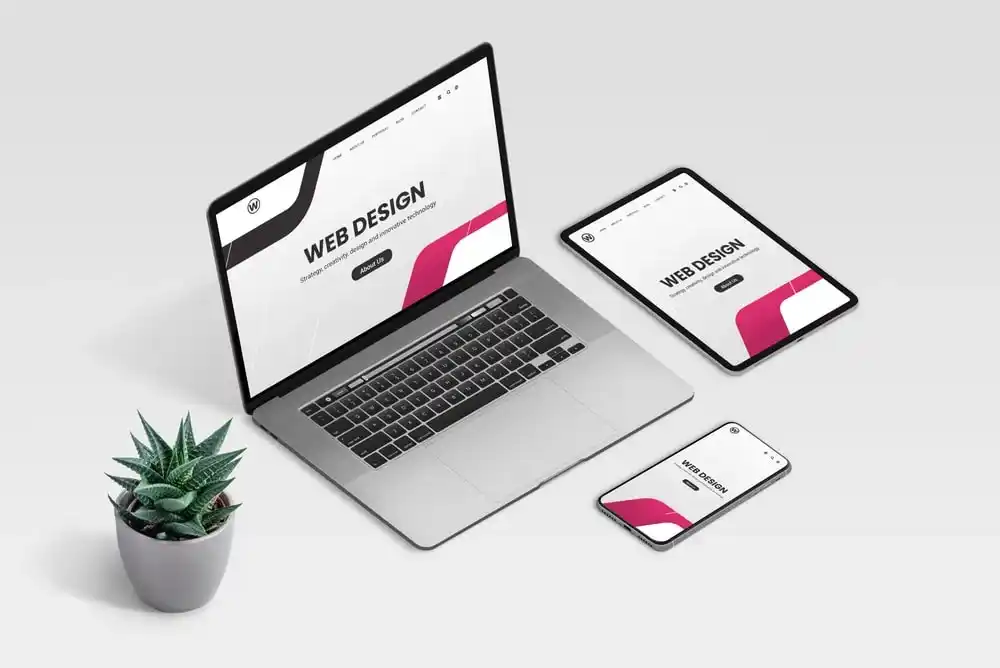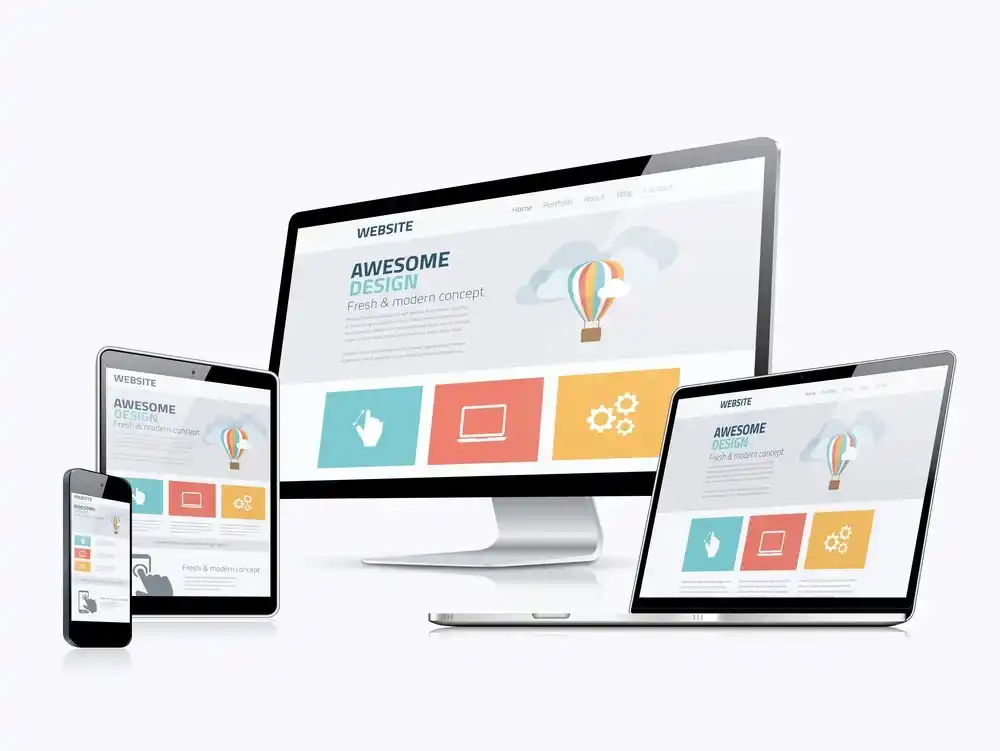Introduction
Today, it is critical to ensure that your website is responsive, which means it operates smoothly and looks good on mobile devices. Mobile responsiveness is a factor in how people engage with your site, impacts your search results, and potentially your income.
However, what does it mean to have mobile responsiveness in a website, and why is it important?
Now, let’s take a closer look at some of the most frequent problems focusing on understanding their root and learning how to solve them.

What is Mobile Responsiveness?
Responsive design can be described as one in which a website is designed in a way that different layouts, contents, and features adjust according to the site’s screen size, to provide the best experience to the user.
You can just imagine your website being able to ‘slide’ to the comfort zone of the user.
You can imagine your website being able to ‘shift’ to the user’s convenient viewing. This is done using some characteristics such as flexible images, a fluid grid, adaptable Text for different screen sizes, and CSS media queries to control how the screen should be styled.
Why Should One Adopt Responsive Web Design?
The old idea which was once known as responsive design has now evolved into a basic prototype and can be used by the designers who are developing responsive websites for contemporary society.
Here’s why embracing responsive design is crucial for your business:

- Improved User Experience: A responsive website has been designed to fit the user’s device, making it easy to use. Of course, your visitors will be OK with unintuitive navigation or content that needs to be more significant to read so that they will remain on your website longer.
- Better Search Engine Rankings: Google and other search engines consider websites that are friendly for mobile devices more relevant. Ensure you use the most responsive website navigation and design. Optimizing it increases your exposure and will help generate more natural traffic to your site.
- Cost-Effective Development: Unlike having several site layouts for different devices, responsive design only allows using several components on a single fluid site. This scenario helps reduce the time and effort spent developing and maintaining IT systems.
- Increased Mobile Traffic and Conversions: A responsive design is beneficial because most users today access websites using tablets or smartphones. It usually improves conversion rates because visitors can search, buy, or complete a form.
- Future-Proof Flexibility: Responsive design prepares your website for new and existing devices shortly. Screens and technologies continue to grow and shrink over time, and you ensure your site will grow and shrink along with them.
Rendering on Different Devices – Desktop and Mobile
Responsive web design is how your website is presented on the target device’s screen. Whether you view your site on a desktop or a mobile device, you need your site to be usable, practical, and visually pleasant.

Here's a quick breakdown of how rendering works on each type of device:
Desktop Rendering
When it comes to desktops, you will get more space on your desktops with desktop view and monitors to work with. You can afford multiple rows, a column layout, big images, and an elaborate menu list view here. Some key characteristics of desktop view rendering include:
More expensive Layouts and Multi-Column Designs: PC monitors can contain more columns and space for sidebars, huge menus, and elaborate system graphics.
Full-Sized Images and Videos: Retinal images and videos of excellent quality can be viewed and seen as they are on desktop monitors without any distortions.
Detailed Navigation Menus: On the desktop, the horizontal links have the top and side links bars with other sub-options in the drop-down format.
Mobile Rendering
Mobile rendering on the other hand is a little different and has to be more user-friendly. It’s not about eliminating the quantity of the content provided—it is about the reorganization of the content according to the screen size.
Single-Column Layouts: The best format for mobile design is often to choose and maintain a one-column layout, which keeps the spacing clean and minimizes the amount of scrolling necessary.
Responsive Images and Fonts: Images are adjusted to be viewed in the screen size to load them up quickly while improving their quality. It also concerns the font size and sizes that are sometimes changed to improve readability.
Touch-Friendly Navigation: The usual button that allows expanding a menu, an option called the ‘hamburger’ menu, is not accessible when used; the clickable objects are also spaced out to avoid accidents.
Optimized Load Times: Mobile networks may at times take a long to load, therefore it is good practice to minimize the size of the scripts and optimize images.
A Few Factors to Bear in Mind to Deliver Across Devices
To achieve and maintain a seamless and seamless user experience out of rendering on both desktop and mobile devices, consider these best practices:

Flexible Grids and Layouts: Developers should employ fluid grid layouts using CSS frameworks such as Bootstrap or Flexbox layouts developed for custom use.
Responsive Images: To create the following image version, use srcset attributes and modern image formats to display and share the full version with the correct image resolution for a particular device.
Adaptive Typography: Use relative units such as rem or em for fonts because they equally adapt to all devices without a problem.
Media Queries: Use media queries in CSS to add different styling for specific widths of pixels on various devices, ensuring the content is well displayed at any screen size.
Below are some of the difficulties designers and developers face when developing websites using RWD and ways developers must overcome them.
As we have seen when designing a website that can adapt to various mobile devices, there are always some challenges that one is bound to encounter.
Here are some of the most common challenges and how to address them:
Unoptimized Images: This is time-consuming and will inconvenience mobile users, and uncompressed full-size images will slow down the page loading.
Overlapping Content: Therefore, the inability of developers to design more flexible layouts leads to numerous overlapping levels, which give the site a rather cluttered look and make the information easier to read.
Poor Touch Elements: Links and buttons placed closely together have the potential to make the navigation process a nightmare.
Solution: Adopt best practices such as using a flexible grid, CSS media, and properly utilizing CSS media queries; media files must be optimized. Viewport meta tags ensure table content scales properly while increasing the space between clickable table elements, making them more responsive and accessible to scroll and hit with a touch. Perform daily and weekly cross-browser testing on actual browsers and emulators and use the Google Mobile-Friendly Test to detect errors.
Mobile Responsiveness: Why Your Website Needs It
As we’ve seen, with mobile web traffic exceeding 50% of the global web traffic, more is needed to have a mobile-friendly website; it is crucial. A mobile-responsive website ensures:

A Better User Experience: Easy to view, navigate, and easier to read, irrespective of the equipment the users are using.
Higher Search Rankings: Mobile first index by Google makes mobile-friendly sites more preferred.
More Engagement and Conversions: In the same way, mobile users are much easier and more likely to engage customers and make purchases when the process is as easy as possible.
Some of the information you absolutely should know about common mobile responsive issues
Despite the increasing importance of mobile responsiveness, many websites still struggle with these common issues:
Unoptimized Images: Images that can be scaled but are not compressed to fit the smaller screen resolution take time to load.
Viewport Scaling Issues: If you have not set up the mobile viewport meta tag correctly, your site may not be responsive, especially in the more mobile view of devices.
Overlapping Content: Therefore, it is essential to understate that when one or both elements extend over or into the two other aspects, the result is usually messages that increase crowding and confusion and thus confuse end users.
Poorly Placed Clickable Elements: When links and buttons are placed side by side, it is difficult for the user to perform tap actions on the smaller link.
Horizontal Scrolling: When designing, forcing users to scroll horizontally should be avoided since it shows that usability is a significant problem usually caused by fixed-width layouts.
What Causes Mobile Responsive Issues?
Several factors contribute to mobile responsive issues, including:
Lack of Media Queries: Responsive web design requires using CSS media queries to define different styles for different device characteristics.
Unoptimized Layouts: Conventional fixed-width designs that scale well can prevent the content from spilling over or squeezing onto mobile devices.
Heavy or Non-Responsive Images: Non-responsive images create a significant issue for usability and accessibility because they do not adjust to the screen size.
Ignoring Mobile-First Principles: A product designed for a large screen and optimized for a smaller one may require an ideal mobile design.
Consequences of Mobile Friendly for SEO
Mobile response is a factor that influences SEO in most of its aspects.
With Google’s Mobile-First Indexing, it is essential to note that the mobile version of your site is the new ‘main’ version that Google uses for ranking and indexing. Key impacts include:
Page Speed: The first requirement is to understand that mobile users require access to the page to be loaded quickly, which is one of the main ranking factors.
Bounce Rates: Failure to meet the expectation of mobile user bounce rates harms the site’s ranking and more traffic elsewhere.
User Engagement: Mobile-friendly designs ensure the user sticks around, stays longer, and spends more, boosting conversion rates and telling search engines that the site is relevant.
The concepts of User Experience and Mobile Responsiveness
Mobile responsiveness is therefore synonymous with optimal user experience, or UX. When users visit a website on their mobile device, they expect:
Clear and Readable Text: Text must adapt to changing screen sizes so that font sizes remain reasonable to read from a smartphone screen.
Easy Navigation: The menus and buttons that are supposed to be clicked should be touch-friendly and straightforward enough to be clicked by touching the screen.
Quick Loading Times: Web pages and documents should undoubtedly take a short time to load on mobile connections, which are generally much slower than fixed broadband connections.
How to Determine That You Have Mobile Responsive Problems on Your Website
To identify mobile responsive issues, start by conducting field and providing a thorough review using these methods:
Manual Testing: Check how the Text content of pages on your website looks when viewed on different gadgets and browsers, including tablets and smart mobile phones.
User Feedback: Collect real-life, rich-out, and user experience feedback to discover the main issues.
Analytics Review: In your analytics, look for high bounce rates and low average session durations on mobile; there might be problems.
Top Resources to Test and Identify Mobile Sensitiveness
Several tools can help diagnose, fix, optimize, improve, and resolve mobile responsive display issues, for example:
Google Mobile-Friendly Test: This link to a free tool by Google lets you instantly verify if your site complies with mobile-friendliness.
Google Search Console: Offers specific reports on mobile usability problems identified by Google.
Browser Developer Tools: Every popular browser has native support for resizing the browser window to mimic various environments and inspecting mobile problems.
Fixing Mobile Responsive Issues: Essential Practices
Dan’s mobile responsive layout issue involves a series of technical adjustments and design changes.
The use of media queries to develop and implement styles based on the device widths is responsiveness.
The viewport meta tag controls page scaling for each screen’s size, dimensions, and height. This guarantees single-page layouts designed for scaling convenience.
Optimizing for touch necessitates amplifying tap zones’ spaciousness around connectors, menus, and buttons.
Increased real estate eases navigating limited mobile spaces with fingertips alone. Yet simplicity remains key lest an overwrought solution births fresh complications worse than the original issue. Carefully crafted modifications deliver a balance between function and form across platforms.
Mobile Web: Enhancing its Web Content
When creating, maintaining, and optimizing content for mobile, consider the following:

Use Short Paragraphs: Subdivide content into several paragraphs rather than one large one to make it more manageable.
Use Bullet Points and Headings. These assist users in faster navigation of the article and content.
Avoid Overusing Pop-ups: Pop-ups negatively impact the user experience of modern browsers and SEO performance.
Techcraftsolution provides solutions for all your problems.
CSS and Its Role in Mobile Responsiveness
Responsive design is built on CSS. Here’s how CSS helps with mobile responsiveness:
Fluid Layouts: CSS flexbox and other grid layout systems enable users to create responsive layouts that change with the device screen size.
Media Queries: These enable the application of many CSS rules depending on the size, resolution, or any other feature of the media.
Another crucial aspect that has to be supported and used in the project is Flexbox and Grids
Both the layout and the grid have to be flexible to create Sites that are optimized for mobile use and responsive.
Ready solutions for creating and testing grid-based, responsive layouts exist in CSS frameworks such as Bootstrap. Use CSS Grid or Flexbox to build responsive layouts on all imaginable devices.
Responsive Media: Images, Videos, and More
The first loading of media files is usually the leading culprit in slow overall page loading speed and leads to poor mobile experience. Here’s how to handle the loading of responsive media with techcraftsolution
Use the srcset Attribute for Images: Categorically provide different image sizes depending on the capabilities of the device users accessing the site.
Responsive Video Embeds: To increase the likelihood that videos will be automatically embedded, adjust the CSS, and configure the width for the video and the aspect ratio to be responsive.
Managing Mobile Usability Testing and Mobile Usability Assessments
It is necessary to perform tests and monitoring to ascertain whether there are mobile types of navigation issues on the site. Well, here’s how to go about it:
Regular Device Testing: If you can, you should look at testing your site on real devices of various sizes and using different operating systems to test and find problems.
Simulate Various Viewports: One should use browser developer tools to imitate multiple devices, icons, and desktop viewports.
Performance Tests: Find and work out how fast your informational web pages open in the coverage area of mobile data networks concerned and optimize and test your code for those aspects as needed.
What is known as the Mobile-First Approach to Web Design
Mobile First is about designing, testing, and building your site with the mobile user as the starting point of creating the first step of your design and development process. Here’s why this practice matters:
Optimized User Experience: Mobile-first design work in a way that can enhance usability by naturally prioritizing key features and navigation.
Better SEO Performance: Currently, Google’s search engine rewards the sites that have been developed with the mobile-first perspective.
Future-Proof Design: As mobile traffic is increasing faster, a mobile-first design is advantageous for your client’s website, customers, and clients.
Conclusion
Responsive design is becoming more popular among businesses. For that reason, there is a need to begin work on mobile-first and responsive web remediation options.
In this case, a mobile-first approach is selected, along with regular website tests and improvements according to the current technological progress.
This guide enables you to become familiar with and control mobile and responsive web design challenges and issues so that your site can be usable for everyone.
If you struggle with mobile responsive issues, contact techcraftsolution and we will help you resolve those challenges, enhancing your website with all devices, ultimately improving your online presence automatically.
FAQs
What are the main mobile phone and internet responsive problems?
The most common issues are non-optimized images, overlaid content, missing or incorrectly sized Text, and close-spaced links.
How can one check if their website is responsive to mobile devices?
Some checks and fixes you can make to your code to ensure you address mobile problems include Google’s Mobile-Friendly Test, browser developer support tools, and Responsinator.
What I want to know is why my website has duplicate html content when my website is viewed on a mobile device?
Similar content is usually observed when using fixed-width layouts or ill-applied media queries that do not adapt to small screen sizes.
What role does mobile responsiveness play in SEO?
Google implements mobile indexing, so the mobile version of a site is prioritized in terms of indexing. Failure in mobile responsiveness results in lower ranking, a high bounce rate of downloads, and less engagement.
How does the use of media queries help achieve mobile responsiveness?
Media queries in CSS are essential when developing responsiveness, as they enable style changes depending on the size and feature of the screen on which the content needs to be displayed.
What is the best way to do image optimization for mobile devices?
To save yourself with images, you can work to reduce their size, for instance, by using image attributes like srcset and using the correct image format for web use, such as WebP.
What is meant by the mobile-first design strategy?
A mobile-first design approach involves designing a website first for mobile devices and then expanding it for larger devices. This makes the site a seamless and rich user experience for mobile users since most of the web traffic comes from such users.
When does my website need to be tested for its mobile responsiveness?
It is advised to continue testing and ensure you test it frequently, although testing is precious after extensive changes. This means it is possible to fix and deal with these problems by adding to the maintenance and ensuring constant testing and monitoring of factors such as those provided, for example, by Google Search Console. To get help you should contact us at techcraftsolution
